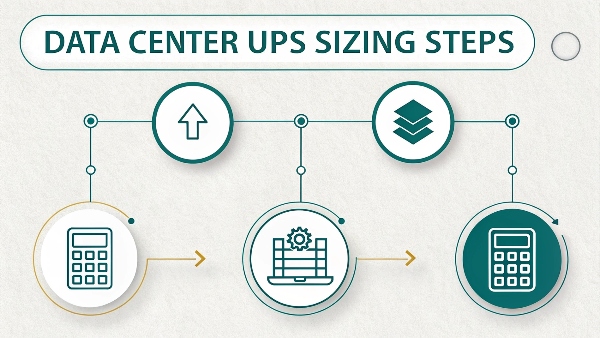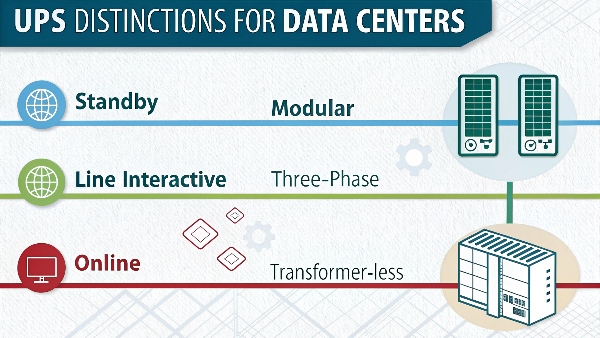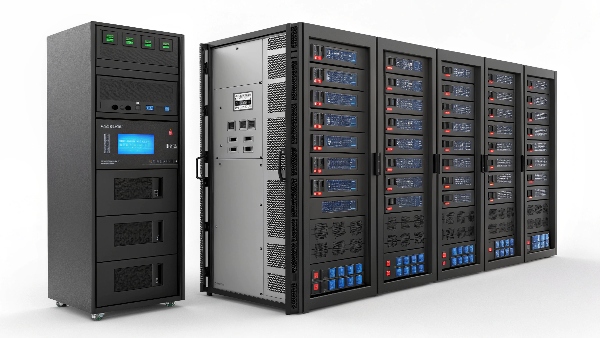Data center downtime is a nightmare, costing millions and damaging reputations. Keeping those servers running, no matter what, is absolutely essential. So, what powers this critical protection?
Data centers almost exclusively use Online (Double-Conversion) UPS systems, often in redundant configurations. These provide the highest level of power protection, ensuring clean, continuous power to sensitive IT equipment.

At DAOPULSE, we've spent 10 years designing and manufacturing uninterruptible power supplies, and data centers are a key area we serve. These facilities are the backbone of the digital world. They can't afford even a millisecond of interruption. When procurement managers from large enterprises or system integrators approach us for data center solutions, their primary concern is unwavering reliability. Uninterruptible power supplies are increasingly vital in data centers. If your data center needs a UPS configuration, please contact us. We at DAOPULSE can provide detailed, customized solutions, from UPS design to selecting the right battery technology, whether lead-acid or advanced lithium.
How to size UPS for data center?
Choosing the wrong UPS size means either overspending on unused capacity or risking catastrophic system failure. Undersizing is a disaster waiting to happen, and oversizing wastes precious budget.
To size a UPS for a data center, calculate the total load of all IT equipment in kVA/kW, factor in future growth (typically 20-30%), and decide on the required redundancy level (e.g., N+1, 2N) and desired battery runtime.

Sizing a UPS for a data center is a critical task. It's not just about adding up the power ratings on your servers. It requires careful planning. I've worked with many clients, like Mr. Li who manages procurement for hospital infrastructure (which has similar critical power needs), to get this right. Here's a more detailed breakdown:
1. Calculate Your Total IT Load
First, you need to know how much power your current equipment draws.
- Inventory IT Equipment: List all servers, storage devices, network switches, routers, and any other powered device in your data center.
- Find Power Ratings1: Check the nameplate or documentation for each device. Power is usually listed in Watts (W) or Volt-Amperes (VA). If only Watts are given, you'll also need the power factor (PF) to calculate VA (VA = W / PF). If PF is unknown, a common estimate is 0.9, but actual values are better.
- Sum the Loads2: Add up all the W and VA figures separately. You'll need both. UPS systems are often rated in kVA (kilovolt-amperes) and kW (kilowatts).
2. Plan for Future Growth
Data centers rarely stay static. New servers and technologies are added.
- Estimate Expansion: A common rule of thumb is to add 20-30% capacity for future growth. If you anticipate significant expansion, you might go higher. This prevents needing to replace your UPS too soon. At DAOPULSE, we design modular UPS systems that allow for easier scaling.
3. Determine Redundancy Level
Redundancy ensures that if one UPS component fails, another takes over.
- N: Basic capacity with no redundancy. Not recommended for data centers.
- N+1: One extra module or UPS unit than required to power the load. If one fails, the others can handle it. This is a common and cost-effective redundancy.
- 2N: Fully redundant. Two independent UPS systems, each capable of powering the entire load. Offers very high availability.
- 2N+1: Two independent systems, plus an extra module in each. The highest level of redundancy.
4. Decide on Battery Runtime
How long do you need the UPS to power your equipment during an outage?
- Short Runtime (5-15 minutes): Enough time for an orderly shutdown of systems or for a generator to start. This is typical if you have a backup generator.
- Longer Runtime (30+ minutes): May be needed if you don't have a generator or if you need to ride through more extended, common outages. Our lithium battery UPS solutions can offer extended runtimes with a smaller footprint compared to traditional lead-acid.
| Here's a simplified example: | Sizing Factor | Consideration | Example Value |
|---|---|---|---|
| Current IT Load | Sum of all equipment (kVA & kW) | 100 kVA / 90 kW | |
| Future Growth (25%) | Add 25% to current load | 125 kVA / 112.5 kW | |
| Redundancy (N+1) | If one 125kVA module is N, N+1 needs two 125kVA modules or a larger modular system | Total capacity of 250kVA if using two discrete units for N+1. Or a 150kVA system with 2x75kVA modules where one is redundant. | |
| Desired Runtime | Time to shutdown or generator start-up | 10 minutes |
Our team at DAOPULSE uses specialized tools and expertise to perform precise sizing calculations, ensuring our UPS design and customization perfectly match our clients' needs, backed by CE, RoHS, and ISO certifications.
What are the six types of UPS?
You know about standby, line-interactive, and online UPS. But then you hear about "six types" and wonder if you're missing crucial information for your data center.
While the three core topologies (Standby, Line-Interactive, Online) are fundamental, "six types" can expand to include distinctions like Single-Phase vs. Three-Phase, Modular vs. Monolithic, and Transformer-based vs. Transformer-less designs, crucial for data center specifics.

While the industry primarily categorizes UPS systems by their operating topology – Standby (Offline), Line-Interactive, and Online (Double-Conversion) – discussions, especially in data center contexts, can introduce other distinguishing features that might lead to a "six types" idea. Let's expand on the core three with other important classifications common in data center applications:
1. Standby (Offline) UPS
As discussed before, passes utility power directly, switches to battery on outage. Not suitable for data centers due to transfer time and lack of power conditioning.
2. Line-Interactive UPS
Includes an Automatic Voltage Regulator (AVR) to correct minor fluctuations without using battery. Better than standby, but the brief transfer time and waveform quality on battery make it generally unsuitable for critical data center loads, though it might be used for non-critical support systems.
3. Online (Double-Conversion) UPS
Continuously regenerates power, providing the cleanest output and zero transfer time. This is the standard for data centers. At DAOPULSE, our patented technology development often enhances the efficiency and reliability of these online systems.
Now, let's add other key differentiators that are especially relevant for data centers:
4. Single-Phase vs. Three-Phase UPS
- Single-Phase UPS: Typically used for smaller loads, like individual workstations, small server closets, or network gear. Output voltage is a single sine wave. Common for UPS units up to around 20kVA.
- Three-Phase UPS: Essential for larger data centers. They take three-phase utility input and provide three-phase output (or single-phase via PDUs) to power entire rows of racks or large equipment. These UPS systems handle much higher power capacities, from 10kVA to several MegaWatts (MW). Our advanced facilities can produce a wide range of both.
5. Modular vs. Monolithic (Standalone) UPS
- Monolithic UPS: A single, standalone unit. If it needs more capacity or if it fails, the whole unit often needs to be replaced or bypassed.
- Modular UPS: Built with multiple smaller power and battery modules. This allows for scalability (add more modules as load grows – N+1 redundancy within a single chassis) and improved maintainability (a faulty module can be hot-swapped without taking the whole system offline). This is a very popular design for modern data centers due to its flexibility and high availability. We specialize in designing customized modular solutions.
6. Transformer-Based vs. Transformer-less UPS
- Transformer-Based UPS: Uses an internal isolation transformer, typically on the output. These are very robust and provide excellent electrical isolation but are larger, heavier, and can be less efficient.
- Transformer-less UPS: Use advanced power electronics to achieve high performance without a bulky internal transformer. They are generally smaller, lighter, more efficient, and have a higher power factor. Most modern data center UPS systems are transformer-less designs.
Understanding these distinctions is vital. For a data center, you're almost certainly looking at Online, Three-Phase, and increasingly, Modular, Transformer-less UPS systems. We ensure seamless project management for such complex installations.
| Classification | Option 1 | Option 2 | Relevance to Data Centers |
|---|---|---|---|
| Topology | Standby, Line-Interactive | Online (Double-Conversion) | Online is standard for critical protection. |
| Phasing | Single-Phase | Three-Phase | Three-phase for high power demands of most data centers. |
| Architecture | Monolithic (Standalone) | Modular | Modular for scalability, redundancy (N+1), and maintainability. |
| Design | Transformer-Based | Transformer-less | Transformer-less for higher efficiency, smaller footprint. |
What is a PDU in a data center?
You've sorted out the main UPS, but then you hear about PDUs. What are they, and are they just fancy power strips, or something more crucial?
A PDU (Power Distribution Unit) in a data center is a device that distributes the conditioned power from the UPS to the servers and other IT equipment within the racks. They range from basic strips to intelligent, networked units.

A Power Distribution Unit, or PDU, is a absolutely essential component in any data center rack. Think of it as the final link in the power chain that delivers reliable power from your large UPS system directly to your individual servers, storage arrays, and network switches. It's much more than just a power strip. While a basic PDU does provide multiple outlets, data center PDUs offer a range of features crucial for managing power effectively.
At DAOPULSE, while our core focus is the UPS system itself, we understand the entire power path. The PDU takes the conditioned, backed-up power from the UPS (which could be a large, centralized three-phase unit) and makes it usable at the rack level.
Here's a breakdown of PDU types and their importance:
Types of Data Center PDUs:
-
Basic PDUs:
- These are the simplest form, providing reliable power distribution from a single input to multiple outputs. They offer robust outlets and are built for durability.
- Think of them as industrial-strength power strips designed for data center environments.
-
Metered PDUs:
- Rack Metered PDUs: These provide local and/or remote monitoring of the aggregate power consumption at the PDU level. This helps data center managers understand power usage per rack, identify available capacity, and prevent overloads.
- Outlet Metered PDUs: These go a step further, allowing monitoring of power consumption for each individual outlet on the PDU. This is invaluable for detailed energy tracking, billing, and capacity planning for specific devices.
-
Switched PDUs:
- These PDUs allow for remote on/off/reboot control of individual outlets. This is incredibly useful for remotely power-cycling unresponsive servers or equipment, saving a trip to the data center floor. They often include metering capabilities as well.
-
Intelligent/Managed PDUs:
- This is a broader category that often encompasses metered and switched functionalities. They connect to the network (Ethernet) and can be managed via web interfaces, SNMP, or other protocols. They can provide alerts for power events, environmental conditions (with optional sensors for temperature/humidity), and detailed reporting.
Why are PDUs critical?
- Reliable Power Delivery: They ensure that the clean power from the UPS is safely and efficiently distributed to the IT load.
- Outlet Density: Racks are packed with equipment. PDUs (often mounted vertically, "0U") provide the necessary number of outlets in a compact form factor.
- Power Management: Intelligent PDUs enable detailed monitoring and control, which is essential for optimizing energy use, managing capacity, and improving uptime. This aligns with needs for supply chain efficiency and optimized product offerings that clients like Mr. Li value.
- Load Balancing: With three-phase power common in data centers, PDUs help ensure that power is drawn evenly across phases.
For a system integrator, selecting the right PDU is just as important as selecting the right UPS. Our team at DAOPULSE can provide guidance on the overall power infrastructure, ensuring our customized UPS solutions integrate seamlessly with the chosen PDU strategy to meet the client's specific project demands.
Conclusion
Data centers rely on Online, often three-phase, modular UPS systems for ultimate protection. Proper sizing and intelligent PDUs are key for efficient, reliable power distribution from the UPS to critical IT loads.

